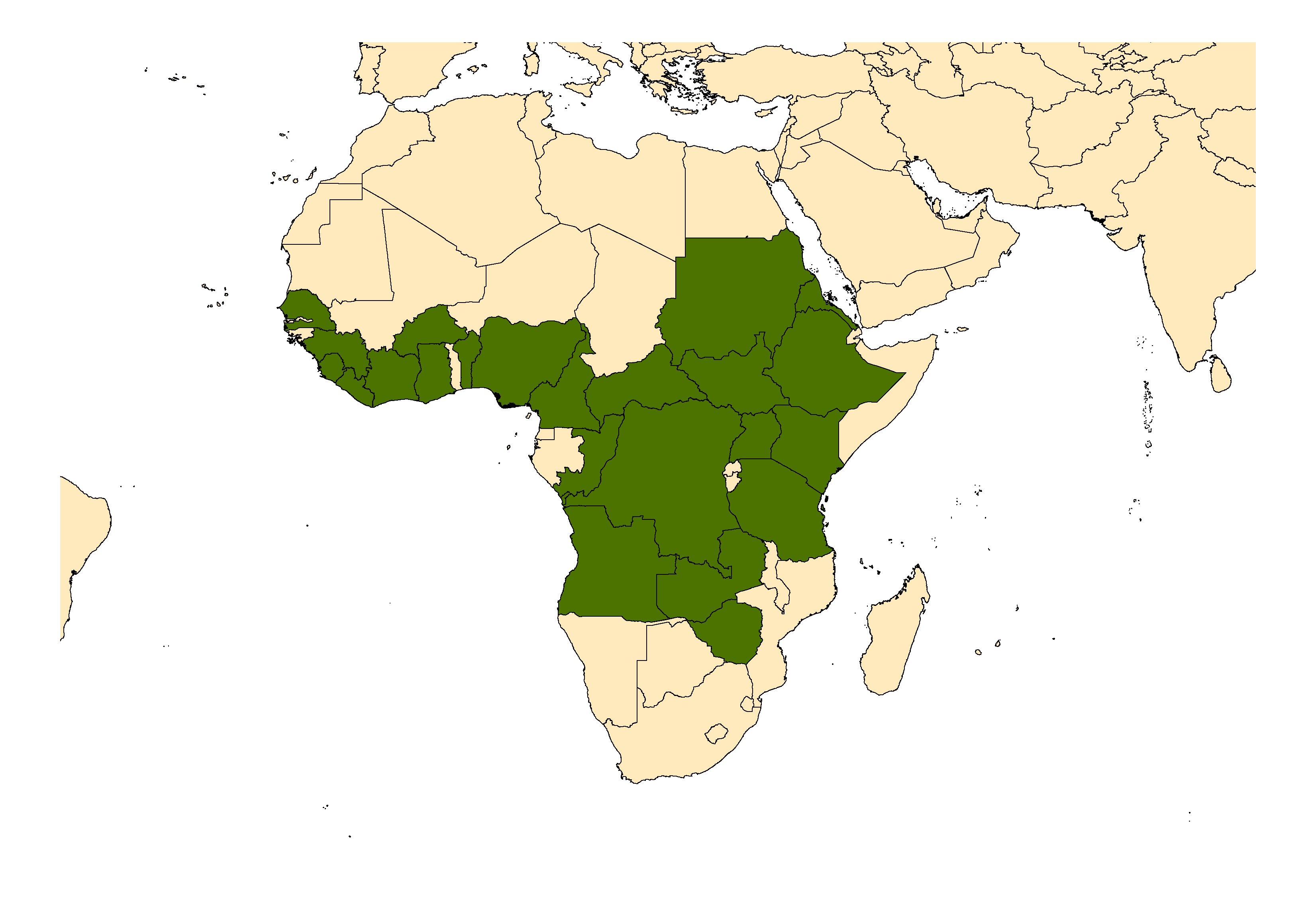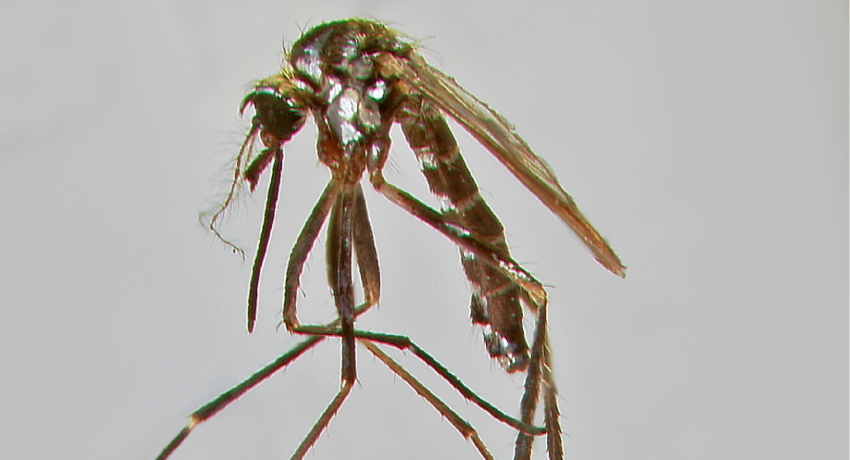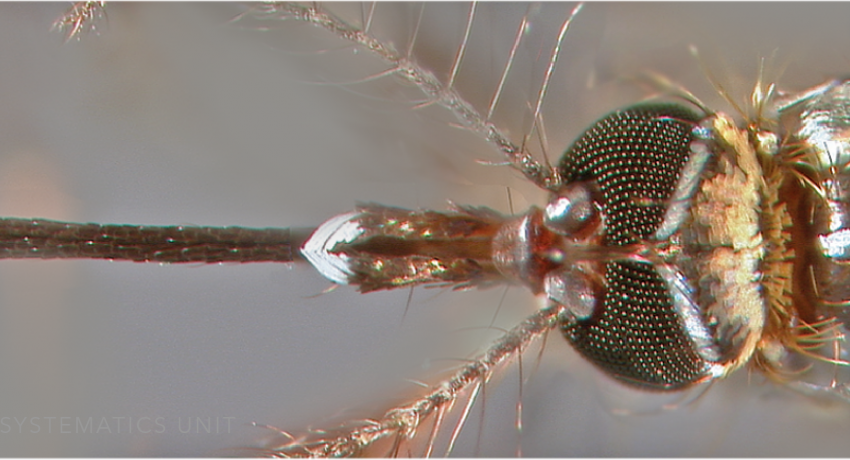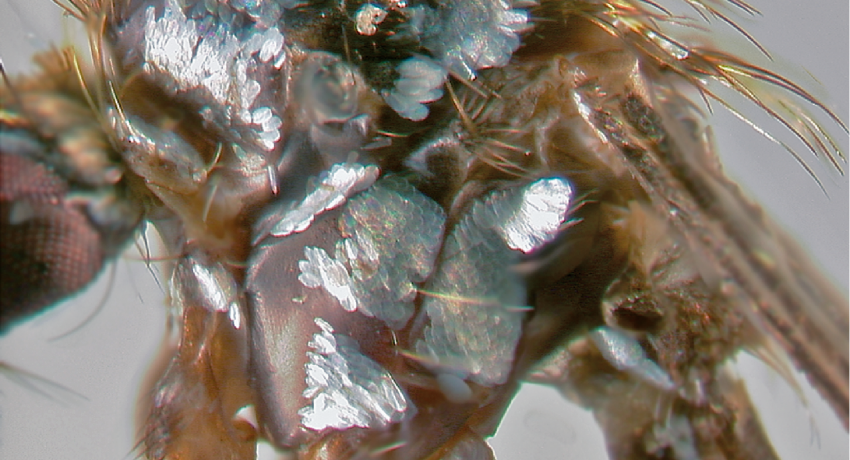AFROTROPICAL REGION
Etymology: not stated [yellow-headed (L)]
Aedes luteocephalus occurs widely across sub-Saharan Africa (north of South Africa), and serves as a major Afrotropical vector of chikungunya, dengue, yellow fever, and Zika viruses. Aedes luteocephalus is placed within the Africanus Group and is commonly confused with Ae. africanus (Theobald) both as adults and as larvae. As adults, the species can be differentiated by the hind femur—which has a large pale band at the base and two large white patches on the anterior median and apical areas in Ae. luteocephalus, whereas Ae. africanus has three large white patches on the anterior basal, median and apical areas. The larvae can be differentiated using characters of the comb scales and pecten spines.
Type locality: Kumba, Belgian Congo [Democratic Republic of the Congo]
Type depository: Natural History Museum, London, England, United Kingdom (NHMUK)
DIAGNOSTIC CHARACTERS (Click photos to view; mouse over and click large photo to zoom in.)
ADULT (illustrated): Head: Proboscis entirely dark-scaled; palpus with white scales at apex; pedicel with lateral and mesal scales. Thorax: Scutum with distinct median line of narrow golden scales; lateral scutellar lobe scales all broad; Postpronotal scales present; proepisternal scales white; subspiracular area with broad white scales; mesepimeron covered with white scales. Legs: Ta-I-III with only basal bands; Fe-II with three large white anterior spots; Fe-III anterior surface with basal pale band and white spots on median and apical areas; Ta-III3 about 0.5–0.8 white; Ta-III4 dark. Abdomen: Terga with basal bands and basolateral white spots.
LARVA (not illustrated): Head: Seta 1-A very small, weakly developed; seta 4-C prominent, many branched; seta 5-C single, about same level as 7-C; setae 4,6-C distinctly anterior to 7-C. Terminal segments: Comb scales spatulate, apex rounded but slightly narrowed apically, surrounded by short fringe; CS in single row; four pairs of seta 4-X; pecten spines with 2 ventral, and 1 or 2 small dorsal, denticles.
TAXONOMIC KEYS
Jupp 1996
Huang 2004
![]()
WRBU – Aedes – Afrotropical Region – Larva
Exemplar DNA sequences
Ae. luteocephalus COI: AY645234–40, KU380354, KU380387, KU380427, KU380469, KU380472, MG242504
BIONOMICS
Immatures
Like Ae. aegypti (Linnaeus), Ae. luteocephalus was originally a forest mosquito but it is now commonly found in village and urban sites. In arboreal environments, biting rates are higher in the forest canopy than at ground level, indicating the species can be an important zoonotic bridge vector. It readily bites at ground level in villages and in the forest, and is most active during the evening crepuscular period.
Adults
In forest habitats, eggs are laid above the water line in tree holes, branch forks and rot-holes (up to 9m high in the canopy), and occasionally, in broken or cut upright bamboo stems. In domestic environments, the species has adapted to artificial containers Eggs are stimulated to emerge on flooding of the larval habitat and undergo installment hatching, contributing to the long season that this species is present.
DISTRIBUTION NOTES
Angola, Benin, Burkina Faso, Cameroon, Central African Republic, Congo, Côte d'Ivoire, Democratic Republic of the Congo, Eritrea, Ethiopia, Ghana, Guinea, Liberia, Mali, Mozambique, Nigeria, Senegal, Sierra Leone, Sudan & South Sudan, Tanzania, Uganda, Zambia, Zimbabwe.

WRBU VECTOR HAZARD REPORTS
None; View other WRBU Vector Hazard Reports
Available GIS Models
Ae_luteocephalus_Foley_1 Africa
Ae_luteocephalus_Nyari_1 Africa
IMPORTANT REFERENCES (full citations below)
Newstead et al. 1907: 15 (F*; Stegomyia)
Macfie & Ingram 1922 (F)
Edwards 1941: 151 (M*, F*), 391(P)
Hopkins 1952: 157 (L*)
Mattingly 1952: 245, 286 (taxonomy)
Huang 1990: 25 (M*, F*, P*, L*; lectotype designation; distribution)
Jupp 1996 (M*, F*; key)
Huang 2004 (M., F; taxonomy, keys, distribution)
CURRENT SYNONYMS
None
CITED REFERENCES
Abílio, A. P., Kampango, A., Armando, E. J., Gudo, E. S., das Neves, L. C., Parreira, R., ... & De Almeida, A. P. G. (2020). First confirmed occurrence of the yellow fever virus and dengue virus vector Aedes (Stegomyia) luteocephalus (Newstead, 1907) in Mozambique. Parasites & Vectors, 13(1), 1-8.
Edwards, F.W. (1941). Mosquitoes of the Ethiopian Region. III. Culicine adults and pupae. Bulletin of the British Museum (Natural History) Entomology.
Hopkins, G.H.E. (1952). Mosquitoes of the Ethiopian region. I. Larval bionomics of mosquitoes and taxonomy of culicine larvae (2nd ed.). London, UK: British Museum (Natural History).
Huang, Y.-M. (1990). The subgenus Stegomyia of Aedes in the Afrotropical Region I. The Africanus group of species (Diptera: Culicidae). Contributions of the American Entomological Institute, 26(1), 1–90.
Huang, Y.-M. (2004). The subgenus Stegomyia of Aedes in the Afrotropical Region with keys to the species (Diptera: Culicidae). Zootaxa, 700, 1–120.
Jupp, P.G. (1996). Mosquitoes of southern Africa. Culicinae and Toxorhynchitinae. Ekogilde Publishers, Hartebeespoort, South Africa, 156pp.
Macfie, J.W.S., & Ingram, A. (1922). On the genital armature of the female mosquito. Annals of Tropical Medicine and Parasitology, 16, 157–188.
Mattingly, P.F. (1952). The subgenus Stegomyia (Diptera: Culicidae) in the Ethiopian region I. A preliminary study of the distribution of species occurring in the West African sub-region with notes on taxonomy and bionomics. Bulletin of the British Museum (Natural History) (B), 2, 233–304.
Newstead, R., Dutton, J. E., & Todd, J. L. (1907). Insects and other Arthropoda collected in the Congo Free State. Annals of Tropical Medicine and Parasitology, 1, 1–112.
CITE THIS PAGE
Walter Reed Biosystematics Unit (Year). Aedes luteocephalus species page. Walter Reed Biosystematics Unit Website, http://wrbu.si.edu/vectorspecies/mosquitoes/luteocephalus, accessed on [date (e.g. 03 February 2020) when you last viewed the site].










































































































































































